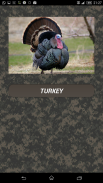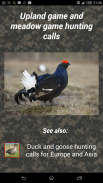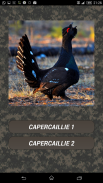







Turkey hunting calls

Descrizione di Turkey hunting calls
Turkey calls: Hunting sounds Mating calls. program turns your mobile phone into a electronic hunting bird caller . Here you will find the voice of upland fowl and meadow fowl, as well as their image. For best effect can be connected to an external active speaker.
In the library of voices included hunting calls such as:
1. Capercallie call. The western capercaillie (Tetrao urogallus), also known as the wood grouse, heather cock or just capercaillie, is the largest member of the grouse family.
2. Black grouse call. The black grouse or blackgame or blackcock (Tetrao tetrix) is a large game bird in the grouse family. It is a sedentary species, breeding across northern Eurasia in moorland and bog areas near to woodland, mostly boreal. The black grouse is closely related to the Caucasian grouse.
3. Hazel grouse call. The hazel grouse, (Tetrastes bonasia) sometimes called the hazel hen, is one of the smaller members of the grouse family of birds. It is a sedentary species, breeding across northern Eurasia as far east as Hokkaido, and as far west as central and eastern Europe, in dense, damp, mixed coniferous woodland, preferably with some spruce.
4. Willow ptarmigan calls. The willow ptarmigan (Lagopus lagopus) is a bird in the grouse subfamily Tetraoninae of the pheasant family Phasianidae. It is also known as the willow grouse and in the British Isles, where it was previously believed to be a separate species, as the red grouse. It is a sedentary species, breeding in birch and other forests and moorlands in northern Europe, the tundra of Scandinavia, Siberia, Alaska and northern Canada, in particular in the provinces of Newfoundland and Labrador. It is the state bird of Alaska.
5. Partridge calls. Partridges are medium sized non-migratory gamebirds, with a wide native distribution throughout the Old World, including Europe, Asia, and parts of Africa. They are sometimes grouped in the Perdicinae subfamily of the Phasianidae (pheasants, quail, etc.). However, molecular research suggests that partridges are not a distinct taxon within the family Phasianidae, but that some species are closer to the pheasants, while others are closer to the junglefowls.
6. Peasant calls. Pheasants are birds of several genera within the subfamily Phasianinae, of the family Phasianidae in the order Galliformes. The family's native range is restricted to Asia.
7. Turkey calls. The turkey is a large bird in the genus Meleagris, which is native to the Americas. One species, Meleagris gallopavo (commonly known as the domestic turkey or wild turkey), is native to the forests of North America, mainly Mexico and the United States.
8. Woodcock calls. The woodcocks are a group of seven or eight very similar living species of wading birds in the genus Scolopax. Only two woodcocks are widespread, the others being localized island endemics. Most are found in the Northern Hemisphere but a few range into the Greater Sundas, Wallacea and New Guinea. Their closest relatives are the typical snipes of the genus Gallinago.
9. Snipe calls. A snipe is any of about 25 wading bird species in three genera in the family Scolopacidae. They are characterized by a very long, slender bill and crypsis plumage. The Gallinago snipes have a nearly worldwide distribution, the Lymnocryptes snipe is restricted to Asia and Europe and the Coenocorypha snipes are found only in the Outlying Islands of New Zealand.
Write to feedback your suggestions to improve the program. If the program will be in demand may create a hunting calls program with the voices of animals.
La Turchia chiama: la caccia suona. programma trasforma il tuo cellulare in un chiamante elettronico per la caccia agli uccelli. Qui troverai la voce di gallinacei e gallinacei, nonché la loro immagine. Per un migliore effetto può essere collegato a un altoparlante attivo esterno.
Nella libreria di voci incluse chiamate di caccia come:
1. Chiamata Capercallie. Il gallo cedrone occidentale (Tetrao urogallus), noto anche come gallo cedrone, gallo erica o solo gallo cedrone, è il membro più grande della famiglia del gallo cedrone.
2. Chiamata di fagiano di monte. Il fagiano di monte o il blackgame o il blackcock (Tetrao tetrix) è un grande uccello selvatico della famiglia dei galli cedroni. È una specie sedentaria, che si riproduce attraverso l'Eurasia settentrionale nelle brughiere e nelle zone palustre vicino ai boschi, per lo più boreali. Il fagiano di monte è strettamente correlato al fagiano di monte.
3. Chiamata di gallo cedrone nocciola. Il gallo cedrone, (Tetrastes bonasia) talvolta chiamato gallina nocciola, è uno dei membri più piccoli della famiglia degli uccelli galli cedroni. È una specie sedentaria, che si riproduce in tutta l'Eurasia settentrionale fino all'estremo oriente dell'Hokkaido e fino all'ovest dell'Europa centrale e orientale, in boschi di conifere densi, umidi e misti, preferibilmente con alcuni abeti rossi.
4. Willow pernice bianca chiama. La pernice bianca (Lagopus lagopus) è un uccello della sottofamiglia di tetraoninae della famiglia fagiano Phasianidae. È anche conosciuto come il fagiano di salice e nelle Isole britanniche, dove in precedenza si credeva fosse una specie separata, come il fagiano di monte. È una specie sedentaria, che si riproduce in betulla e in altre foreste e brughiere nel nord Europa, nella tundra di Scandinavia, Siberia, Alaska e Canada settentrionale, in particolare nelle province di Terranova e Labrador. È l'uccello di stato dell'Alaska.
5. Chiamate pernici. Le pernici sono uccelli selvatici non migratori di medie dimensioni, con un'ampia distribuzione nativa in tutto il Vecchio Mondo, tra cui Europa, Asia e parti dell'Africa. A volte sono raggruppati nella sottofamiglia Perdicinae dei Phasianidae (fagiani, quaglie, ecc.). Tuttavia, la ricerca molecolare suggerisce che le pernici non sono un taxon distinto all'interno della famiglia dei Phasianidae, ma che alcune specie sono più vicine ai fagiani, mentre altre sono più vicine agli uccelli della giungla.
6. Chiamate contadine. I fagiani sono uccelli di diversi generi all'interno della sottofamiglia Phasianinae, della famiglia Phasianidae nell'ordine Galliformes. La gamma nativa della famiglia è limitata all'Asia.
7. Turchia chiama. Il tacchino è un grosso uccello del genere Meleagris, originario delle Americhe. Una specie, Meleagris gallopavo (comunemente noto come tacchino domestico o tacchino selvatico), è originaria delle foreste del Nord America, principalmente Messico e Stati Uniti.
8. Woodcock chiama. Le beccacce sono un gruppo di sette o otto specie viventi molto simili di trampolieri del genere Scolopax. Solo due beccacce sono diffuse, le altre essendo endemiche localizzate dell'isola. La maggior parte si trova nell'emisfero settentrionale, ma alcuni si estendono nelle Grandi Sundas, Wallacea e Nuova Guinea. I loro parenti più stretti sono i tipici cecchini del genere Gallinago.
9. Chiamate snipe. Uno snipe è una delle circa 25 specie di uccelli trampolieri in tre generi della famiglia Scolopacidae. Sono caratterizzati da un becco molto lungo, sottile e piumaggio da cripta. I cecchini di Gallinago hanno una distribuzione quasi mondiale, il cecchino di Lymnocryptes è limitato in Asia e in Europa e i cecchini di Coenocorypha si trovano solo nelle Isole periferiche della Nuova Zelanda.
Scrivi per commentare i tuoi suggerimenti per migliorare il programma. Se il programma sarà richiesto può creare un programma di chiamate di caccia con le voci degli animali.

























